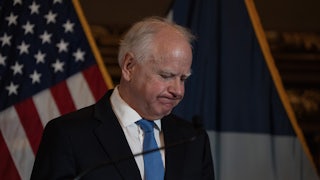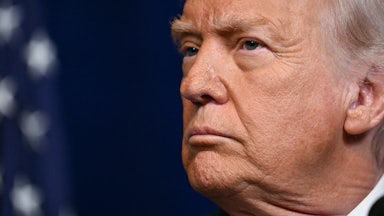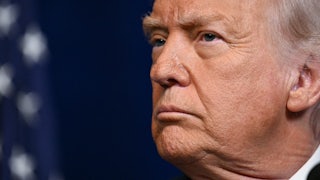American democracy is in distress, its future uncertain. No single solution will fix all its problems, but one popular idea of the past few years—on the left, anyway—is to grant statehood to Puerto Rico and the District of Columbia. Doing so would first and foremost grant the people of the Caribbean territory and federal district, respectively, the representation in Congress and governmental autonomy that they deserve. It would also shake up the pro-rural—and thus pro-conservative—bias of the Electoral College and Senate. But a similar, complementary solution has been overlooked: tribal statehood.
In 1898, the Five Civilized Tribes of Oklahoma (so named because of their willingness to adopt Western forms of economic and social ties) were facing a crisis. It had become clear the U.S. government was once again reneging on its promises by planning to abolish their tribal governments and force them to cede most of their land to white settlers. In response, the Five Tribes held a convention to form an Indian state. They drafted a constitution and proposed a state government for the potential Native American–controlled state of Sequoyah. The referendum was approved by a majority of Native American and white voters, but Congress never considered their request.
Instead, Oklahoma was admitted as a state in 1907, following President Theodore Roosevelt’s proposal to combine Oklahoma Territory with Indian Territory. Despite becoming part of the new state of Oklahoma, the people—and their lands—who would have formed the state of Sequoyah retained their separate legal status, as the Supreme Court in McGirt v. Oklahoma recently reaffirmed. Because tribal lands remain sovereign territories, tribes possess a constitutional pathway to an alternative form of self-governance. Tribes can seek statehood.
In drafting a constitution, creating a plan of government, and electing delegates to petition Congress for statehood, Sequoyah followed a process other territories used to become states, providing a model for tribes today. Through statehood, tribes would gain direct representation in Congress, accrue power over the selection of presidents through the Electoral College, and influence national priorities and policies. In a closely divided partisan moment in the nation’s history, tribal states might do more than benefit tribal members; they could also reorient the political map in ways that help to arrest the slide of American democracy.
Recent events make this constitutional pathway to statehood potentially very attractive. Like the Five Tribes more than a century ago, today’s tribal nations are poised to lose a measure of control over their people and lands. In June, the U.S. Supreme Court decided Oklahoma v. Castro-Huerta, which for the first time ever eliminated the presumption against state jurisdiction in Indian country for crimes committed against Indians by non-Indians. Because this decision limits the effect of the court’s reasoning in McGirt, Justice Neil Gorsuch objected to the erosion of tribal control, saying that “where this Court once stood firm, now it wilts.”
Castro-Huerta is likely just the first of other drastic reductions in tribal sovereignty the Supreme Court might impose. On November 9, the Supreme Court will hear arguments in Brackeen v. Haaland. The case concerns the constitutionality of the Indian Child Welfare Act, or ICWA, a 40-year-old federal statute that provides different rules for the removal, placement, and adoption of Indian children. The Brackeen plaintiffs argue that the special rules for the adoption of Indian children are racially discriminatory. This is not a new argument, and the court has repeatedly held the act is constitutional. However, the changed composition of the court, combined with the recent Castro-Huerta decision, suggests that this time the outcome might be different. If so, the implications of the Brackeen decision will not be limited to the ICWA. Finding the act unconstitutional could mean the end of most tribal rights.
Federal Indian law is the body of law that pertains to American Indian tribes and their citizens. Like the ICWA, nearly all federal Indian law is based on the distinction between race and political classification. These laws pass constitutional muster because the term “Indian” is defined as a political classification based on a person’s membership or eligibility for membership in a federally recognized tribe. It is not a racial designation. Consequently, if the Brackeen plaintiffs win their discrimination claim, then the ICWA provisions, as well as most other federal Indian laws, will be considered unconstitutional racial classifications. If this happens, tribal statehood might be the best solution for tribes to maintain their political self-determination.
As states, tribes would retain governmental control over their land and citizens and have the same relationship with the United States as all other states. They would also have the same obligations. They would have to satisfy the Constitution’s Article IV requirement to maintain a republican form of government and create a state constitution not “repugnant to the principles of the Declaration of Independence,” as Congress has frequently required. Within these parameters, a tribe would have flexibility in assigning the relationship between executive, legislative, and judicial power, so long as it maintained their proper separation. As states, tribes could also control state lands and parks, and set laws, consistent with the Constitution, to govern the transfer of private property, to make contracts, and a host of other legal matters within their jurisdiction. As tribal rights are increasingly threatened, such powers, even with their limitations, may be incredibly attractive to many tribes.
There is no single method for becoming a state. Sequoyah provides one model, which begins when a territory or tribe takes the initiative to petition Congress for admission. Alternatively, Congress could take the initiative through an Enabling Act that in effect invites a territory to undergo the process of ratifying a constitution and forming a government for purposes of seeking admission. A tribe following the Sequoyah model would have the advantage of demonstrating in advance that a majority desires statehood and that it is committed to the principles of democracy enshrined in the Constitution—two criteria that Congress has used when deciding upon state admission.
Congress would also consider whether a territory has sufficient population and taxable resources to support the state government and contribute its share to the federal government. Under this condition, tribes with the largest populations and geography would be in the best position to seek statehood, though there is no necessary minimum. Nevada was admitted as a state with no more than 40,000 inhabitants (and had fewer than 7,000 residents a few years prior to admission). Although not all tribal lands will be of sufficient size and population, many, such as the Creek in Oklahoma or the Navajo in Arizona, clearly are.
Once a state, other constitutional obligations would follow. For example, tribal states would be barred by the Due Process and the Privileges and Immunities clauses from placing any special burdens on newcomers to the state. Tribal states could write protections into their state constitutions for cultural sites and tribal heritage but would be required to protect religious equality and neutrality. In these and many other ways, a tribe would have to navigate potentially nettlesome trade-offs in giving up some privileges in order to gain others. Nevertheless, these gains could be significant. Direct representation in Congress of issues central to tribal constituents would mean they would suddenly become matters of national attention. In a closely divided Congress, tribal voices could not be ignored.
From the national perspective, the fewer the inhabitants of the new tribal state, the more it will distort democratic representation—a plus for the newly admitted lower-population state that gets the same number of senators as the largest-population state, but a minus overall for representation equality. Nevertheless, a Senate stagnating under the weight of its own procedures might also benefit from expanded numbers and a jolt of new members who are nonetheless long-standing constituents of the nation. Moreover, given the threats to democracy percolating in some states, new admittees dedicated to preserving and strengthening democratic institutions might provide an indispensable counterweight to anti-majoritarian threats.
Because new tribal states would mean changes to existing state boundaries, the makeup of the Senate, and the apportionment of House members, we can expect fierce pushback against any tribe that applies for admission as a separate state. The principal objection will derive from Article IV of the Constitution, which provides that “no new State shall be formed or erected within the Jurisdiction of any other State.” In a strictly geographical sense, all tribes reside within the territory of a state, and thus a state government could be expected to argue that any tribal reservation within its geographical boundaries is within its jurisdiction. Were the Navajo Nation, for example, to seek statehood as one of the largest tribes by population, all three states within whose geographic boundary its lands fall—Arizona, New Mexico, and Utah—would likely object. Oklahoma would also likely object to partitioning in order to facilitate a tribal state, given its history of combining lands held by native populations with those of settlers.
In McGirt, the Supreme Court confirmed that except in very limited circumstances, tribal lands do not fall within the legal jurisdiction of the states within which their geographical boundaries are located. McGirt followed long-standing precedent. As Chief Justice John Marshall wrote almost two centuries ago, tribes are “domestic dependent nations,” meaning they are “distinct independent political communities” subject to the overriding sovereignty of the federal government but not that of the states. Congress recognized this independent sovereignty when it made it a condition for the admission of states like Arizona, the Dakotas, Montana, and New Mexico that the new state governments disclaim any rights over tribal lands within their geographical boundaries. Because tribal states are not within the jurisdiction of any state, the Constitution erects no barrier to their admission.
The states where Indian tribes are located have long been recognized as the “deadliest enemies” of Indian people, as the Supreme Court explained in 1886. It is why states were presumed to lack jurisdiction over crimes committed against Indians in Indian country, and also why protective legislation like the ICWA was passed. The congressional hearings preceding the passage of the ICWA highlighted the disproportionately high rates of Indian child removals and showed that these removals were frequently unjustified and based on ignorant and racist assumptions about Indian families perpetrated by state governments and agencies. If the court strikes down the ICWA in Brackeen, the protections against such removal will disappear. Once again, Indian families will be at risk of harmful and unnecessary state intervention—unless the state is the tribe.
Congress could, of course, refuse to consider admission of new tribal states on political grounds. The Republicans almost surely would do so, as they have done with Puerto Rico and D.C., because of the possibility that a majority of voters in such states would support the Democratic Party. But the difficulty of the fight is no reason not to wage it, and partisan advantage is not the point. The tribes deserve self-determination and equal political status just as much as Puerto Rico and D.C. do; all Americans will benefit from it. As the conservative supermajority on the Supreme Court works to undo rights and potentially strengthen the hand of politically gerrymandered state legislatures to decide democratic elections as they see fit, expanding democratic institutions is an important path to strengthening them.






